Gaseous Biofuels: Biogas
Biogas (swamp gas, landfill gas or digester gas) is a fuel gas, a mixture consisting of 50 – 80% methane (CH4) and 20 - 50% CO2 with trace amounts of H2S. It is a renewable energy resulting from biomass. Although it’s a resource comparable to fossil gas, its dispersed and recovery is not easily recoverable. (Ref. Biogas Europe) Fermentation (or anaerobic digestion) is the process of degradation of the organic substances using the micro-organisms.
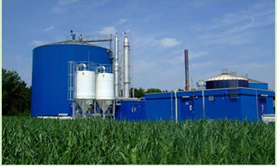
(Image Ref: http://www.biogas-india.com/)
Technology
Technology for biogas is ahead of that of thermal gas. Anaerobic digestion processes are already commercialized. These are set up for specific environmental problems or are deployed in landfills, which are managed to capture the methane that is naturally produced.
Biomass is generated by anaerobic digestion, a process known as fermentation wherein organic substances are degraded using the microbes. The organic wastes such as sewage, animal by-products, agricultural, industrial, and municipal solid waste gets decomposed without oxygen to generate biogas. Examples of organic wastes: intensive animal husbandry (excreta, and bedding materials); food processing (sugar production and vegetable preparation); breweries and distilleries; and materials production (such as pulp and paper, pharmaceutical manufacture, and sewage treatment) can all be fermented to produce biogas. Yield and composition of biogas depends on composition of organic wastes, production technology and collection of the gas. Landfills 40 feet deep with 1 million tonnes of Waste can be practically used to collect bio-methane (Ref: Alternative Fuels Data Center)
There are three stages of methanogenesis from organic wastes
- Hydrolysis - Microbes decompose the complex carbohydrates, lipids and proteins into more simple compounds.
- Acidification acid-producing bacteria convert the simplified compounds into acetic acid (CH3COOH), hydrogen (H2), and carbon dioxide (CO2).
- Methane formation - obligatory anaerobes decompose simple compounds into methane.
After generation the gas is refined to increase its proportion of methane and decrease CO2. Other contaminants like H2S, N2, water and particulates are also removed. Various techniques such as absorption, adsorption, membrane separation, or cryogenic separation can be used for refinement. The biomass of the degrading and non digested organic matter can be returned to soil as sludge if it does not contain heavy metals.
Uses - Biogas can be used to generate Electricity (for running machines, lighting), Heat and can also serve as a fuel. In kitchen it can substitute firewood, dung, agricultural residues. In vehicles: When processed to purity standards, biogas can substitute natural gas in vehicles. Sweden has 50% natural gas vehicles running on biogas (Ref: Alternative Fuels Data Center), as a mixed fuel for irrigation systems. It also provides multiple environmental benefits (see below)
Environmental benefits of Biogas
- The use of anaerobic digestion becomes more significant as water quality issues become more significant. Animal production units are concentrated in areas that no longer have the required land to absorb the impacts of concentrated animal feed operations compromising the water quality. ( Ref : Yadwad et al. 2012 IJERT ). COD (Chemical Oxygen Demand) reduced between 60 and 80%. Possible pathogenic microflora also reduced.
- Producing biogas through anaerobic digestion reduces landfill waste and odors,
- Biogas technology produces nutrient-rich liquid fertilizer.
- The technology requires less land than aerobic composting.
- Biogas utilization prevents environmental emission of Methane which is 21 times stronger green house gas. ( Ref: Alternative Fuels Data Center).
- Reduction in emission of pollutants.
Challenges and Scope for Research and Technology Development
Optmized biogas could lead to diversified use. However it is crucial that optimization is energy efficient and is executed in an eco friendly manner.
- Research on the diversity of degrading microbial communities is required so that biogas technologies can be optimized. If the micro-organisms act in a concerted manner it will lead to efficient production of biogas which can be economically viable. Introduction of H2 producing bacteria to natural collection of microbes was shown by Hungarian researchers to boost biogas production. (Ref: Eco –innovation observatory, Hungary).
- Treatment and elimination of organic waste can be done using various approaches often involving biological systems. E.g. H2S removal by microbes with added Oxygen. (Ref: Biogas upgrading technologies).
- Various innovative technologies are being developed for improvement of biogas production and its efficient use. Challenge areas are : costs of biogas production and purification, producing higher-quality natural gas from biogas, and performance evaluation and enhancement of biogas-fueled vehicles. (Ref: Alternative Fuels Data Center).
Some examples of technology challenges (Ref: IEA biogas net)- Removal of H2S using NaOH results into highly caustic solutions.
- Removal of Nitrogen and Oxygen is expensive.
- Limitations of upgrading techniques like in situ Methane enrichment for fibrous substrates.
- Technology of eco friendly upgrading techniques using carbonic anhydrase is expensive and viability of enzyme is a challenge.
- Scaling up.
- Introduction of intermittent steps like pre-treatment of organic wastes and their utilization.
India's Biogas Technology
With an estimated potential of ~ 17000 MW (Ref : Biogas Technology in India) India's Biogas (Gobar gas) technology could be a vehicle for rural employment, an intervention to stop Women's drudgery of firewood collection and freeing up their energy and time. Cleaner fuel would reduce risks of several respiratory disorders. Various government sectors (via national projects), Khadi and Village Industries Commission (KVIC), and NGOs are in place to promote and disseminate information of this technology and have been trying to evolve this technology as early as 1930s. Due to these efforts 25% potential of this technology is already realized (Ref : Yadwad et al. 2012 IJERT). Government of India offers subsidies and many fiscal incentives to promote the technology.
Various models like Janata, Deenbandhu involving floating drum, fixed drum has been developed by KVIC, state governments and research organizations for household biogas plants.
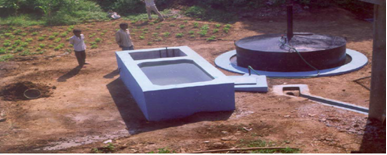
Floating Drum
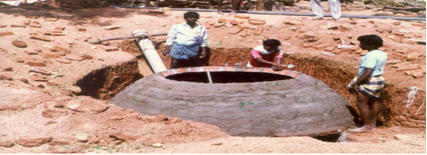
Fixed Drum
(Ref for both images: MNRE presentation, Anil Dhussa)
Currently ~ 2000 small and medium size biogas plants (5-25 kW)are operational in many Indian states. Various organic wastes used in various states of India include Tapioca processing effluents, slaughterhouse wastes, dairy industry wastes, bagasse, poultry droppings, washwater of paper industries
Relevent research is needed in the areas of low temperature anaerobic digestion, digestion of mixed wastes, conversion of biogas to bio-CNG, development of microturbines and technologies for moisture removal from slurry. (Ref : MNRE presentation, Anil Dhussa)
Ideal biogas technologies for India: Biogas technology can be viable and workable if it is preferably generated from within the community and locally maintained. Simple technological innovations like a tool to reduce particle size of biomass would be relevant. Biogas from water hyacinth can not only be a more efficient system (due to harvested Nickel) but also help in getting rid of the weed. Techniques for dissemination, implementation and monitoring of biogas plants. Community biogas plants as against household ones would help eliminate problems of water availability and resources particularly for the marginalized populations. Technologies to coordinate the communal operations and logistics are necessary as well.
Biogas flames may not be ideal for making 'Chapatis' or fulfilling other specific needs of Indian cooking. Education and training of stake - holders would also be an effective strategy.
There are several barriers to growth of biogas industry. There is lack of awareness about importance of biogas compounded by absence of training and regulation standards. There are hurdles in securing finace. Forums like Indian Biogas Association (IBA) have been established which bring nationwide operators, manufacturers and researchers together. Together they can promote the technology and address some of the barriers. Social constraints associated with dealing with organic wastes can also be a hurdle in using this technology. Although installed the biogas plants fail to deliver due to inappropriately large size, faulty constructions and lack of skilled technicians. Customized solutions for local habitats may ameliorate some of the problems.
Biogas Technology and Pune
Pune has acquired a model city status for biogas technology thanks to efforts of research organizations like Agharkar research institute, NGOs like ARTI and a very active local government.
Research and Technology Development - Agharkar research institute has isolated, identified and characterized anaerobic bacteria including hydrolytic, syntrophic and methanogenic microbes from multiple sources. These studies facilitate optimization and improvement of biogas technology. Various organic wastes have been experimented with and consultancies provided to companies. Other research includes design of bioreactors, biological clean-up of biogas, improving cow dung based biogas, bioinoculum packet development. The group at ARI actively publishes its research and is also involved in training for the technology. (Ref: ARI website - Microbial Sciences)
Efforts by Appropriate Rural Technology Institute (ARTI) : A compact biogas plant based on food developed under leadership of Dr. Anand Karve has won Ashden award. Currently 2000 units are in use (Ref : ARTI website).
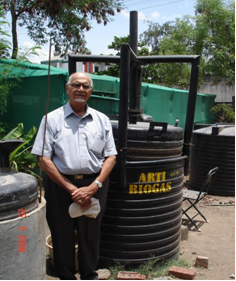
(Ref : ARTI website)
The system claims to generate 500 g of Methane from 2 Kg of organic wastes (like non edible seeds, mis-shapen fruits, left - over food etc) in 24 hours thus providing high efficiency over conventional Gobar gas plants. The system is suitable for urban needs.
Pune Municipal Corporation - in collaboration with Maharashtra Energy Development Agency (MEDA) has set an example by developing municipal solid waste biomethanation plants for power generation. These plants are operational at 11 locations within the city. ( Ref: MNRE website)
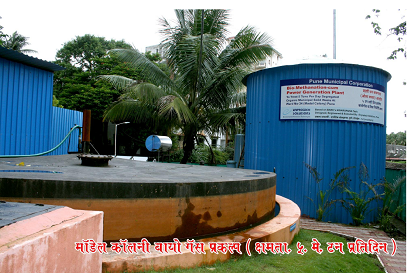
( Image Ref : MNRE Website MEDA biogas PMC)
Pune city is one of the highest accumulators of municipal solid wastes (MSW) with 0.4 kg of MSW generated per person. The city solid wastes generated from vegetable markets, hotels, hostels, homes have upto 90% moisture and are therefore suitable for methanogenesis. The city has separate vehicle system for collection of segregated wet wastes which are decomposed at its source in a de-centralized manner. This has also saved costs of transportation to landfills. All steps from collection, segregation to clean up are carried out using manual/machine operations. Biogas generated is used to generate electricity for city lights, biogas operations and manure is used in municipal gardens.
Other efforts - Bio CNG - developed from press mud at Warna co-operative Sugar factory, Kolhapur is being considered as a fuel for commercial vehicles by MNRE. The technology is developed by Hyderabad-based Spectrum Renewable Energy Private Ltd. to conduct more tests of bio-CNG on trucks. ( Ref: Times of India, February 2012). The testing is being done by Automotive Research association, Pune.
Website ref: http://www.biogas-india.com/
